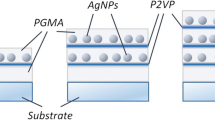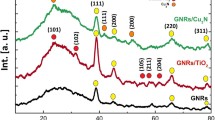Abstract
A model system of metal nanocomposite structures separated by dielectric layers has been developed to reveal the impact of the dielectric matching layer on surface plasmon resonance (SPR) in multilayer structures. The research results indicate that SPR is highly sensitive to the dielectric constant and interface thickness of the dielectric layer. The dielectric constant and thickness of the dielectric layer together determine the propagation characteristics of the electromagnetic wave within the medium. The thickness of the dielectric layer affects the propagation distance of the electromagnetic field within the layer, while the dielectric constant regulates the speed and extent of the medium’s response to changes in the electric field. In this study, when the dielectric layer thickness is less than 30 nm, localized surface plasmons and propagating surface plasmons can couple between gold nanoparticles and gold films, with the coupling effect being more pronounced when the dielectric layer thickness is between 10 and 20 nm. Conversely, when the dielectric layer thickness exceeds 30 nm, the electromagnetic field is effectively isolated, hindering the coupling effect, with the localized surface plasmon resonance becoming the primary mechanism. Within the illumination range of 400 to 1200 nm, the dielectric constant within the range of 1.4 to 3.8 exhibits an approximately linear relationship with the wavelength of the absorption peak, with electric field intensity reaching its maximum when the dielectric constant is close to 2.6. Therefore, in the design and optimization of optical devices, precise control of the plasmon resonance modes can be achieved by systematically adjusting the thickness and dielectric constant of the dielectric layer.







Similar content being viewed by others
Data Availability
No datasets were generated or analyzed during the current study.
References
Rahman A, Islam MdS, Alharbi M et al (2024) X-shaped exposed core highly sensitive plasmonic sensor for cancer cell detection. Opt Quantum Electron 56:718. https://doi.org/10.1007/s11082-024-06392-w
Pirhaghshenasvali S, Ghayour R, Vaghefi M (2024) Highly sensitive biosensor based on nanoparticle/grating: a case study on detecting waterborne bacteria in drinking water. Opt Quantum Electron 56:602. https://doi.org/10.1007/s11082-023-06204-7
Bliokh YP, Felsteiner J, Slutsker YZ (2005) Total absorption of an electromagnetic wave by an overdense plasma. Phys Rev Lett 95:165003. https://doi.org/10.1103/PhysRevLett.95.165003
Kupersztych J, Raynaud M, Riconda C (2004) Electron acceleration by surface plasma waves in the interaction between femtosecond laser pulses and sharp-edged overdense plasmas. Phys Plasmas 11:1669–1673. https://doi.org/10.1063/1.1650353
Akimov YuA (2007) Resonant excitation of counterpropagating surface waves at a Langmuir wave decay. Plasma Phys Rep 33:310–315. https://doi.org/10.1134/S1063780X0704006X
Yao M, Tan O, Tjin S-C, Wolfe J (2008) Effects of intermediate dielectric films on multilayer surface plasmon resonance behavior. Acta Biomater 4:2016–2027. https://doi.org/10.1016/j.actbio.2008.06.002
Radziuk D, Möhwald H (2015) Surpassingly competitive electromagnetic field enhancement at the silica/silver interface for selective intracellular surface enhanced Raman scattering detection. ACS Nano 9:2820–2835. https://doi.org/10.1021/nn506741v
Li Q, Yang S, Liu R et al (2023) Synergetic effect of the interface electric field and the plasmon electromagnetic field in Au-Ag alloy mediated Z-type heterostructure for photocatalytic hydrogen production and CO2 reduction. Appl Catal B Environ 331:122700. https://doi.org/10.1016/j.apcatb.2023.122700
Romano S, Zito G, Managò S et al (2018) Surface-enhanced Raman and fluorescence spectroscopy with an all-dielectric metasurface. J Phys Chem C 122:19738–19745. https://doi.org/10.1021/acs.jpcc.8b03190
Kuryoz PYu, Poperenko LV, Kravets VG (2013) Correlation between dielectric constants and enhancement of surface plasmon resonances for thin gold films. Phys Status Solidi A 210:2445–2455. https://doi.org/10.1002/pssa.201329272
Al-Qadi B (2022) T-matrix simulations of the optical response of gold nanorods: Impact of dielectric function of nanorods on the simulated optical properties and their sensitivity to the dielectric environment. AIP Adv 12:095002. https://doi.org/10.1063/5.0102601
Afsharnia M, Hamidi SM (2018) Characterization of Au/Fe/Au and Au/Co/Au magneto-plasmonic multilayers as an ethanol vapor sensor. IEEE Trans Magn 54:1–7. https://doi.org/10.1109/TMAG.2017.2761754
Zhu D, Kang L, Tong K et al (2023) Research on surface plasmon resonance sensing of metal nano hollow elliptic cylinder. Plasmonics. https://doi.org/10.1007/s11468-023-01930-w
Pandit RR, Sentoku Y (2012) Higher order terms of radiative damping in extreme intense laser-matter interaction. Phys Plasmas 19:073304. https://doi.org/10.1063/1.4739442
Bell AR, Kirk JG (2008) Possibility of prolific pair production with high-power lasers. Phys Rev Lett 101:200403. https://doi.org/10.1103/PhysRevLett.101.200403
Mustafa DE, Yang T, Xuan Z et al (2010) Surface plasmon coupling effect of gold nanoparticles with different shape and size on conventional surface plasmon resonance signal. Plasmonics 5:221–231. https://doi.org/10.1007/s11468-010-9141-z
Dadadzhanov DR, Gladskikh IA, Baranov MA et al (2021) Self-organized plasmonic metasurfaces: the role of the Purcell effect in metal-enhanced chemiluminescence (MEC). Sens Actuators B Chem 333:129453. https://doi.org/10.1016/j.snb.2021.129453
Stevenson PR, Du M, Cherqui C et al (2020) Active plasmonics and active chiral plasmonics through orientation-dependent multipolar interactions. ACS Nano 14:11518–11532. https://doi.org/10.1021/acsnano.0c03971
Huakang Yu, Liu Bodong Wu, Wanling LZ (2019) Surface plasmaons enhanced light-matter interactions. Acta Phys Sin 68:149101–149115. https://doi.org/10.7498/aps.68.20190337
Bhardwaj S, Pathak NK, Ji A et al (2017) Tunable properties of surface plasmon resonance of metal nanospheroid: graphene plasmon interaction. Plasmonics 12:193–201. https://doi.org/10.1007/s11468-016-0249-7
Liu X, Li D, Sun X et al (2015) Tunable dipole surface plasmon resonances of silver nanoparticles by cladding dielectric layers. Sci Rep 5:12555. https://doi.org/10.1038/srep12555
Hong-Wei Y, Ru-Shan C, Yun Z (2006) SO-FDTD method and its application to the calculation of electromagnetic wave reflection coefficients of plasma. Acta Phys Sin 55:3464–3469. https://doi.org/10.7498/aps.55.3464
Golmakaniyoon S, Hernandez-Martinez PL, Demir HV, Sun XW (2016) Cascaded plasmon-plasmon coupling mediated energy transfer across stratified metal-dielectric nanostructures. Sci Rep 6:34086. https://doi.org/10.1038/srep34086
Akimov YuA, Chu HS (2011) Plasmon coupling effect on propagation of surface plasmon polaritons at a continuous metal/dielectric interface. Phys Rev B 83:165412. https://doi.org/10.1103/PhysRevB.83.165412
Zhang N, Zhou P, Wang S et al (2015) Broadband absorption in mid-infrared metamaterial absorbers with multiple dielectric layers. Opt Commun 338:388–392. https://doi.org/10.1016/j.optcom.2014.11.008
Funding
This research was supported by the Natural Science Foundation of Zhejiang Province under grant number LY21F010010.
Author information
Authors and Affiliations
Contributions
The author contributions in the manuscript are as follows: Jing Jin and Xudong Cheng wrote the main draft. Yun Zhou, Zhicheng Dong, and Zhenyu Xue participated in the writing of the results and discussion sections. All authors reviewed their manuscript prior to submission.
Corresponding author
Ethics declarations
Competing Interests
The authors have no relevant financial or non-financial interests to disclose.
Additional information
Publisher's Note
Springer Nature remains neutral with regard to jurisdictional claims in published maps and institutional affiliations.
Rights and permissions
Springer Nature or its licensor (e.g. a society or other partner) holds exclusive rights to this article under a publishing agreement with the author(s) or other rightsholder(s); author self-archiving of the accepted manuscript version of this article is solely governed by the terms of such publishing agreement and applicable law.
About this article
Cite this article
Jin, J., Cheng, X., Zhou, Y. et al. Tunable Surface Plasmon Resonance in Metal-Dielectric Multilayer Structures. Plasmonics (2024). https://doi.org/10.1007/s11468-024-02344-y
Received:
Accepted:
Published:
DOI: https://doi.org/10.1007/s11468-024-02344-y




